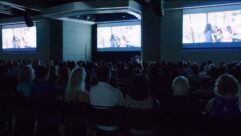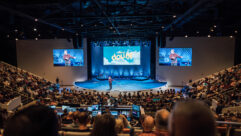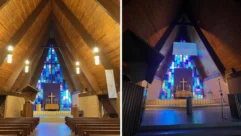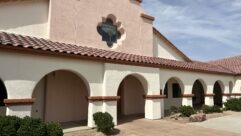St. Mary Church was built in 1872 in Portland, Connecticut. The small town’s claim to fame in those days was its vast brownstone quarries, which supplied the essential building material to Boston, New York, and other growing cities. According to town historians, this industry provided a basis for the town’s economy by encouraging the sister businesses of shipbuilding, transportation, animal husbandry (caring for oxen and horses used in the quarries), blacksmithing, and millwork. This raw material was also featured heavily in the town’s architecture, including St. Mary Church. In the late 1990s, when fire ravaged the church, only the aged brownstone foundation remained. Today’s St. Mary Church rests on that same foundation and houses the ever-present small town’s community of believers.
The church’s reconstruction project began shortly after the devastating fire. This included construction of a main sanctuary in a completely round shape and with a vaulted ceiling of between 45 and 50 feet. This sanctuary can seat as many as 460 people and is surrounded by the smaller Chapel for the Blessed Sacrament, a sacristy, a reconciliation room, a maintenance room, and a morning chapel that seats an additional 50 people. The church, rededicated in November 1995, is now used for the administration of all sacraments, including baptism, first communion, confirmation, and marriages and funerals. Likewise, the sanctuary is utilized for nine masses per week attended by as many as 334 people, as well as town gatherings such as Eagle Scout meetings, concerts, and plays.
Although the open spaces and high ceilings of the reconstructed church certainly provided a fitting space for spirits to soar, it also, unfortunately, presented ample opportunities for soaring echoes. In an entirely circular room, uncontrolled sound can result in numerous problems:
Echoes result from sound bouncing back and forth between surfaces that are hard and flat—for example, wall to wall or ceiling to floor. Echoes can be discrete, causing a single, lingering sound, or flutter echoes can result from rapid movement of the sound wave back and forth, creating a ringing effect.
Sound takes much longer time to decay naturally in a space with high room volume and the low sound absorption. A space such as a church sanctuary has high volume and low absorption, especially if all of the surfaces are parallel and the floor and furnishings are uncovered as in the case of St. Mary. Compounding the issue is the use of additional sound-amplifying tools: a microphone and speakers. The microphone itself is wired to two large speakers mounted overhead and installed by Pascom Audio of Hamden, Connecticut. Additional opportunities for sound problems result from the church services’ musical accompaniments. The church’s electric organ is wired to two additional organ speakers, and parishioners also accompany the masses unplugged using a piano and guitar. The organist also acts as soloist for the masses, singing without a microphone. A choir of 25 parishioners, soon to be joined by a junior choir that is in the process of forming, sings at one mass per week and accompanies congregational singing at the other masses. Taken as a whole, those factors could cause significant, lingering sound reverberation or echo within the space as well as transmission of the noise into the adjoining room.
St. Mary Church contracted with Stanley A. Macbeth in Simsbury, Connecticut, to complete the reconstruction project. The contractor, in turn, found the Proudfoot Company of Monroe, Connecticut, to develop a sound control solution for the main sanctuary. The requirements of the job were to simply ensure that echoes or reverberant sound were not present in the space during services.
For the space, Proudfoot employed its Noisemaster acoustical wall panels. The panels are lightweight, only about 1 pound per square foot, and easy to install using impaling clips, tile adhesive, or hook and loop material. The Class A, ASTM E84–certified panels are covered in a commonly used commercial fabric supplied by Guilford of Maine. This fabric is bonded to the face of the sound-absorbing panel material and around the edges of the panel’s back, producing upholstered corners. In all, 31 panels were used, sized 3 by 7 feet and 3 1/2 by 7 feet as well as 1-inch thick. Each panel has a noise reduction coefficient (the arithmetic mean of the sound absorption coefficients for a specific material in the frequency ranges 250, 500, 1,000, and 2,000 Hz, rounded to the nearest .005) of .85 sabins. This means that each panel provides 85 percent absorption of one square foot of material.
The panels were custom designed to fit the space’s requirements. Many included cutouts for heating vents. All of the panels were designed with rounded edges to allow for the radius of the wall in the circular room. Finally, two colors of fabric were employed to create panels that closely conform with the space’s existing color scheme. The edges of the panels are hardened and customized in a squared shape, mimicking the appearance of the doors below. This rectangular shape is reflected across the room’s design, from the panels and doors to the simple, wooden pews, windows, and decorative brickwork. Likewise, other sound-absorptive materials were used to cover surfaces and lend character to the space. Material was placed in and around the choir loft. Three handwoven, woolen tapestries designed by artist Pamela Baker were commissioned for the space, as well. According to Baker, the tapestries show Biblical images representing man’s hunger for mystical union with God, done in the vivid colors of the liturgical year: green, purple, red, and white. Combined these coverings and the panels ensure that reverberation time in the sanctuary is reduced significantly. Likewise, the products double as decorative additions to the space, adding character and depth without taking away from the original design.
“There are no echoes in the church at any time,” says the Rev. John Ashe, pastor of St. Mary Church. “The panels have proven to be excellent in controlling the sound. We feel that the panels and tapestries have added aesthetic value to the space, as well.”St. Mary Church was rebuilt because of the dedication and faith of its parishioners, and the reconstructed space has proven a welcome addition to the town’s quaint architectural landscape. Luckily, by paying attention to all of the details, including sound control, the church’s community of faith can raise its voice in worship without causing noise.










